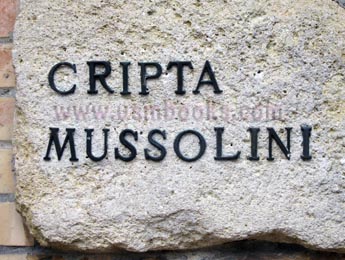The images and text used on this and all other USM web pages are the copyrighted property
of USM Inc. Those images and the text may be used by others ONLY AFTER completion
of a formal international licensing agreement and payment of a licensing fee!
of USM Inc. Those images and the text may be used by others ONLY AFTER completion
of a formal international licensing agreement and payment of a licensing fee!
Most people with an interest in European World War II history are at least somewhat familiar with Benito Mussolini’s stormy rise to power in Italy and his 13 year rule. On 31 October 1922, at age 39, he became the youngest Premier in the history of Italy. He legally reached power in accordance with the Statuto Albertino, the Italian Constitution. The purpose of this article is to familiarize readers with the story of members of Mussolini’s immediate family before and after his death at the hands of Italian partisans in the last week of April 1945. Strange as it may seem to those familiar with the postwar history of Hitler’s relatives and families of other high-ranking Nazis, the Mussolini family suffered little and gained much from their relationship with the Italian dictator.
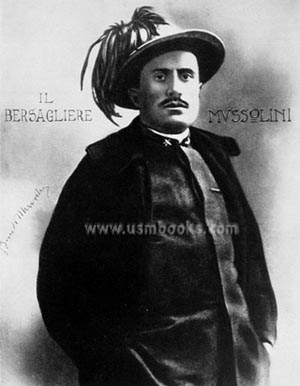
Benito Mussolini photographed in 1915 in his World
War I Bersaglieri uniform. He was on the front line
until wounded on 23 February 1917.
War I Bersaglieri uniform. He was on the front line
until wounded on 23 February 1917.
From 1925 until the mid 1930s Fascism was popular in Italy and experienced little opposition. It evolved into a new political and economic system that combined totalitarianism, nationalism and anti-communism, designed to bind all classes together under a capitalist system (the "Third Way"). This was a new system in which the state took control of the organization of vital industries. In the beginning Mussolini was given support from the full political spectrum in Italy, from leftists to democrats.
Slowly Mussolini started to dismantle parliament democratically with legislation that they had approved. By 1926, he had complete control over the Italian government and people. Under Mussolini, the effectiveness of the parliamentary system was virtually abolished even though its forms were publicly preserved. Law codes were rewritten. All teachers in schools and universities had to swear an oath to defend the Fascist regime. Newspaper editors were personally chosen by Mussolini (a journalist before entering political life) and only those who possessed a certificate of approval from the Fascist Party could practice journalism.
Slowly Mussolini started to dismantle parliament democratically with legislation that they had approved. By 1926, he had complete control over the Italian government and people. Under Mussolini, the effectiveness of the parliamentary system was virtually abolished even though its forms were publicly preserved. Law codes were rewritten. All teachers in schools and universities had to swear an oath to defend the Fascist regime. Newspaper editors were personally chosen by Mussolini (a journalist before entering political life) and only those who possessed a certificate of approval from the Fascist Party could practice journalism.
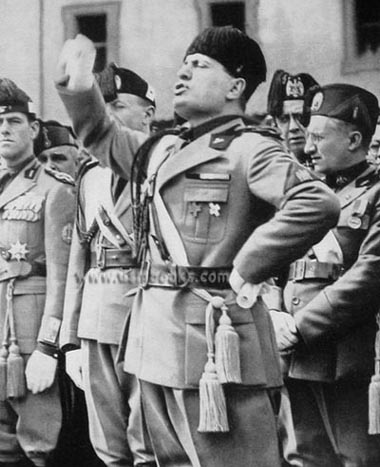
Independence was taken away from trade unions (whose members had helped Mussolini come to power) and they were integrated into what was called the "corporative" system. Mussolini pleased his financial backers by transferring a number of industries from public to private ownership, but by the mid 1930s he had begun moving back to strict governmental control of industry.
In 1927 Mussolini had himself baptized by a Roman Catholic priest in order to remove opposition from Italy's Catholics, who were critical of the modern Italian State which had taken away papal property. In 1929, the “Lateran Treaties” were signed with the Vatican. The Italian state was finally recognized by the Roman Catholic Church and the independence of Vatican City was recognized by the Italian state. Mussolini never became known as a practicing Catholic, but his anti-communist doctrines convinced many Catholics to support him.
In 1927 Mussolini had himself baptized by a Roman Catholic priest in order to remove opposition from Italy's Catholics, who were critical of the modern Italian State which had taken away papal property. In 1929, the “Lateran Treaties” were signed with the Vatican. The Italian state was finally recognized by the Roman Catholic Church and the independence of Vatican City was recognized by the Italian state. Mussolini never became known as a practicing Catholic, but his anti-communist doctrines convinced many Catholics to support him.
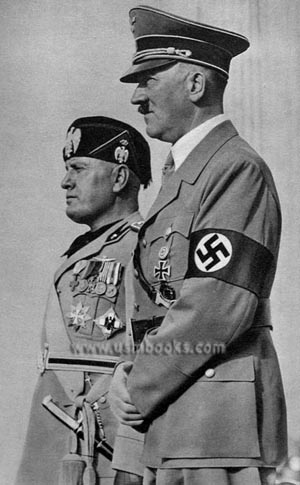
Above, Mussolini addressing his troops in Rome late in October 1922, just prior to becoming Italy’s youngest Prime Minister at age 39. Left, a photo taken in September 1937 with Germany’s 23rd Chancellor Adolf Hitler during Il Duce’s state visit to Germany.
In April 1935, at the Stresa Conference with French Foreign Minister Pierre Laval and British Prime Minister Ramsay MacDonald, Mussolini helped create an anti-Hitler front in the hope of preserving the independence of Austria.
His successful, ruthless war against Abyssinia (Ethiopia) in 1935–1936 was opposed by the League of Nations and that opposition eventually led to Hitler seeking an alliance with fascist Italy. Mussolini’s intervention on the side of Generalissimo Francisco Franco in the Spanish Civil War (1936-1939) ended all possibility of reconciliation with France and Britain. At the Munich Conference in September 1938, Mussolini posed as a moderate working for European peace but his "axis" with Germany was confirmed when he made the "Pact of Steel" with Hitler in May 1939. The term "Axis Powers" was used by Mussolini in November 1936 when he spoke of a Rome-Berlin axis in reference to the treaty of friendship signed between Italy and Germany on 25 October 1936.
His successful, ruthless war against Abyssinia (Ethiopia) in 1935–1936 was opposed by the League of Nations and that opposition eventually led to Hitler seeking an alliance with fascist Italy. Mussolini’s intervention on the side of Generalissimo Francisco Franco in the Spanish Civil War (1936-1939) ended all possibility of reconciliation with France and Britain. At the Munich Conference in September 1938, Mussolini posed as a moderate working for European peace but his "axis" with Germany was confirmed when he made the "Pact of Steel" with Hitler in May 1939. The term "Axis Powers" was used by Mussolini in November 1936 when he spoke of a Rome-Berlin axis in reference to the treaty of friendship signed between Italy and Germany on 25 October 1936.
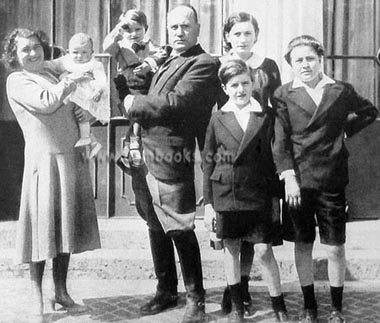
Above, Benito Mussolini and his wife Rachele (née Guidi) surrounded by their five children. Daughter Edda was the eldest child, born out of wedlock in 1910 (her parents did not marry until December 1915). Son Vittorio was born in 1916, Bruno in 1918 and Romano in 1927. Youngest daughter Anna Maria was born in 1929.
Left, Benito Mussolini with famous World War I pilot and Nazi Aviation Minister and Field Marshal Hermann Göring in a photograph taken during the state visit of Il Duce to Germany in September 1937.
Left, Benito Mussolini with famous World War I pilot and Nazi Aviation Minister and Field Marshal Hermann Göring in a photograph taken during the state visit of Il Duce to Germany in September 1937.
In April 1939, after a brief war, he annexed Albania. On 10 June 1940 Mussolini declared war on Britain and France and on 28 October 1940 he attacked Greece. In June 1941 he declared war on the Soviet Union and in December on the United States as well.
Following the Axis defeat in North Africa, setbacks on the Eastern Front and the Allied landings in Sicily, most of Mussolini's colleagues turned against him at a meeting of the Fascist Grand Council on 25 July 1943. King Vittorio Emanuele III called Mussolini to his palace and stripped him of his power. Upon leaving, Mussolini was arrested, imprisoned and replaced by Pietro Badoglio, who immediately declared in a famous speech La guerra continua a fianco dell'alleato germanico ("The war continues at the side of our Germanic allies").
Following the Axis defeat in North Africa, setbacks on the Eastern Front and the Allied landings in Sicily, most of Mussolini's colleagues turned against him at a meeting of the Fascist Grand Council on 25 July 1943. King Vittorio Emanuele III called Mussolini to his palace and stripped him of his power. Upon leaving, Mussolini was arrested, imprisoned and replaced by Pietro Badoglio, who immediately declared in a famous speech La guerra continua a fianco dell'alleato germanico ("The war continues at the side of our Germanic allies").
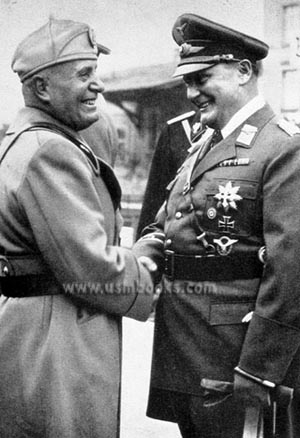
However, in private he was working to negotiate a surrender. On 29 September 1943, Badoglio as Head of the Italian Government, officially signed an armistice with General Dwight D. Eisenhower, Commander-in-Chief of the Allied Forces at Malta.
On 28 August 1943, after having been imprisoned on the islands of Ponza and Sardinia, Mussolini was moved to a ski resort near the town of L’Aquila on Gran Sasso mountain (elevation 2112 meters / 6900 feet) in central Italy, accessible only by cable car. He was rescued from Gran Sasso mountain on 12 September 1943 in a spectacular high-risk raid, Unternehmen Eiche or Operation Oak, planned by German General Kurt Student and carried out with gliders and a Fieseler Storch aircraft by SS-Hauptsturmführer Otto Skorzeny and a group of German paratroopers. After Mussolini’s rescue he was flown from Rome to Vienna and on 15 September met with Adolf Hitler at the Führer’s Wolfs Lair headquarters at Rastenburg in Eastern Prussia.
On 28 August 1943, after having been imprisoned on the islands of Ponza and Sardinia, Mussolini was moved to a ski resort near the town of L’Aquila on Gran Sasso mountain (elevation 2112 meters / 6900 feet) in central Italy, accessible only by cable car. He was rescued from Gran Sasso mountain on 12 September 1943 in a spectacular high-risk raid, Unternehmen Eiche or Operation Oak, planned by German General Kurt Student and carried out with gliders and a Fieseler Storch aircraft by SS-Hauptsturmführer Otto Skorzeny and a group of German paratroopers. After Mussolini’s rescue he was flown from Rome to Vienna and on 15 September met with Adolf Hitler at the Führer’s Wolfs Lair headquarters at Rastenburg in Eastern Prussia.
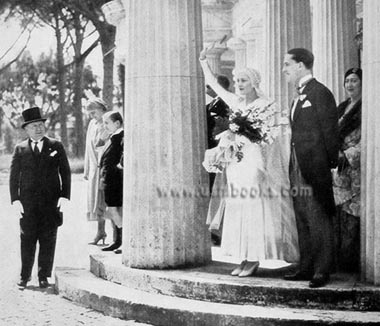
Above, Benito Mussolini looks at his oldest daugter Edda after her marriage to Galeazzo Ciano, Count of Cortellazzo and Buccari, on 24 April 1930. The lavish ceremony took place at Villa Torlonia, the official state residence of Mussolini in Rome, and was attended by 4000 guests.
On 23 September 1943, Mussolini set up the Italian Social Republic (RSI, Repubblica Sociale Italiana), a fascist state in German-occupied northern Italy. He lived at Villa Feltrinelli in Gargnano, north of Salò on Lake Garda, and was able to rule only under the protection of his German liberators. In this "Republic of Salò" Mussolini returned to his earlier ideas of socialism and collectivization. He executed some of the members of the Fascist Grand Council who had turned against him in the summer of 1943, including his son-in-law, Count Ciano on 11 January 1944.
Benito Mussolini spent his last seven days in power in Milan, the city of his rise to power. On 20 April 1945 he disbanded his government and on 22 April the city of Bologna was captured by rapidly advancing Allied troops. Mussolini’s staff and friends tried to persuade Il Duce to flee to Spain but he refused to leave Italy.
Benito Mussolini spent his last seven days in power in Milan, the city of his rise to power. On 20 April 1945 he disbanded his government and on 22 April the city of Bologna was captured by rapidly advancing Allied troops. Mussolini’s staff and friends tried to persuade Il Duce to flee to Spain but he refused to leave Italy.
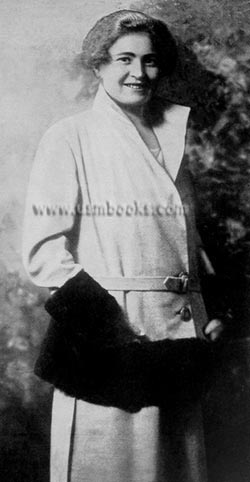
The "Republic of Salò" came to an end on 25 April 1945 when a general partisan uprising and the Allied spring offensive managed to oust most of the Germans from Italy. The same day, Mussolini (driving his own Alfa Romeo and accompanied by his mistress Claretta (Clara) Petacci) and his remaining entourage left Milan in a convoy headed north toward Lake Como on their way to Valtelline, a key alpine pass between northern Italy and Germany (now Austria). News reached them of the decree from the Liberation Committee calling for the death penalty for Fascists responsible for the 1922 "insurrection" and those guilty of crimes against the state since 8 September 1943. Mussolini was captured by Italian partisans on 27 April just outside the town of Dongo and in the afternoon of 28 April 1945, he was executed next to the gate to Villa Belmonte (photo left, October 2009) outside the small town of Mezzegra on the western shore of Lake Como.
The next day his body and those of several other Fascists shot the previous day in the town square of Dongo, were taken to Milan where Mussolini’s corpse was hung from a roof truss of a gas station at Piazzale Loreto.
The next day his body and those of several other Fascists shot the previous day in the town square of Dongo, were taken to Milan where Mussolini’s corpse was hung from a roof truss of a gas station at Piazzale Loreto.
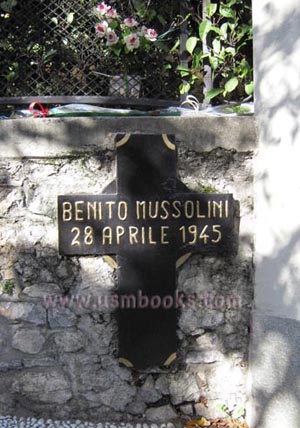
The Allies ordered the bodies removed for burial. Mussolini's body was buried in an unmarked grave in Musoco Cemetery in Milan. It was dug up and moved several times before 1 September 1957 when, after many requests by Mussolini's widow Rachele, his remains were buried in a private ceremony at the family vault in San Cassiano cemetery at Predappio, the small village near Forlì in Emilia-Romagna near the Adriatic coast, where Benito Andrea Amilcare Mussolini was born on 29 July 1883.
He was survived by his wife Rachele, by two sons, Vittorio and Romano, and two daughters, Edda and Anna Maria. A third son, pilot Bruno died in the crash of a P108 bomber on 7 August 1941. At the time of his death, Bruno Mussolini was married to Gina Ruberti who drowned during a late night boating party with British soldiers on Lake Como on 4 May 1946, at age 29. They had one daughter, Marina, born on 18 March 1940 in Rome.
He was survived by his wife Rachele, by two sons, Vittorio and Romano, and two daughters, Edda and Anna Maria. A third son, pilot Bruno died in the crash of a P108 bomber on 7 August 1941. At the time of his death, Bruno Mussolini was married to Gina Ruberti who drowned during a late night boating party with British soldiers on Lake Como on 4 May 1946, at age 29. They had one daughter, Marina, born on 18 March 1940 in Rome.
Mussolini’s widow Rachele returned to Predappio after the war and ran a restaurant. She sued the Italian State and was awarded a widow’s pension in 1968. In 1971 she sued again and was awarded an increase in monthly pension payments. She died on 30 October 1979 and is buried in the Mussolini family crypt at San Cassiano cemetery in Predappio, near her husband.
Edda was the couple’s oldest child, born out of wedlock to Benito Mussolini and Rachele Guidi in Forlì, Emilia-Romagna in 1910. Her parents married in December 1915.
11 April 1890 - 30 October 1979
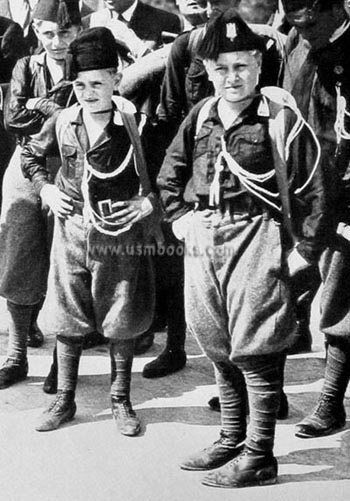
After the family moved to Rome she met Galeazzo Ciano, Count of Cortellazzo and Buccari, son of Admiral Count Costanzo Ciano (a naval officer, (WWI) war hero and Fascist Minister of Communications). They were married on 24 April 1930 in a lavish ceremony in Rome. Edda Mussolini became Edda Ciano, Countess of Cortellazzo and Buccari. Her husband was appointed Italian Consul in Shanghai and their first son, Fabrizio Ciano was born there on 1 October 1931. The family moved back to Italy in 1932 where Ciano soon took the post of Minister of Foreign Affairs. They had two more children, daughter Raimonda (nicknamed Dindina) in December 1933 and son Marzio in December 1937.
In July 1943, when internal opposition against Benito Mussolini emerged in the Fascist Grand Council, Count Ciano voted against his father-in-law. For doing so he was later arrested, tried for treason and executed by firing squad in Verona on 11 January 1944, despite Edda's appeals to her father.
In July 1943, when internal opposition against Benito Mussolini emerged in the Fascist Grand Council, Count Ciano voted against his father-in-law. For doing so he was later arrested, tried for treason and executed by firing squad in Verona on 11 January 1944, despite Edda's appeals to her father.
After her 41 year old husband’s death Edda escaped to Switzerland. She managed to smuggle out Ciano's wartime diaries and had them published after the war. After returning to Italy from Switzerland, Edda was held on the island of Lipari and on 20 December 1945 was sentenced to two years imprisonment for aiding Fascism. After her release she lived in Rome with her three children and for several years also raised her brother Bruno’s orphaned child Marina.
Her autobiography La mia vita was published in English as “My Truth” in 1975. She died in Rome on 9 April 1995.
Her son Fabrizio Ciano wrote a book called Quando il nonno fece fucilare papà (“When Grandpa had Daddy Shot”) about the events of 11 January 1944, when Mussolini ordered the execution of his son-in-law. He died on 8 April 2008 in San Jose, Costa Rica, unmarried and without children.
In November 1952, Raimonda Ciano married Alessandro Giunta, a descendant of Napoleon's brother Lucien Bonaparte, in St. Mark's Basilica in Rome. Her mother Edda and grandmother Rachele were in attendance. Raimonda Ciano died in Rome on 25 May 1998.
Marzio Ciano was married to Gloria Lucchesi. They separated in August 1965 and he died in 1974.
Her son Fabrizio Ciano wrote a book called Quando il nonno fece fucilare papà (“When Grandpa had Daddy Shot”) about the events of 11 January 1944, when Mussolini ordered the execution of his son-in-law. He died on 8 April 2008 in San Jose, Costa Rica, unmarried and without children.
In November 1952, Raimonda Ciano married Alessandro Giunta, a descendant of Napoleon's brother Lucien Bonaparte, in St. Mark's Basilica in Rome. Her mother Edda and grandmother Rachele were in attendance. Raimonda Ciano died in Rome on 25 May 1998.
Marzio Ciano was married to Gloria Lucchesi. They separated in August 1965 and he died in 1974.
Above, Mussolini’s sons Bruno (left) and Vittorio in about 1930. In October 1935 the two appeared with their father on the cover of TIME magazine (below). Bruno, a pilot died in a plane crash in 1941 at age 23 and Vittorio died in 1997 at age 80. Benito Mussolini was on the cover of TIME magazine eight times between 6 August 1923 and 21 June 1943.
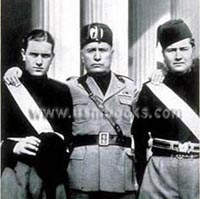
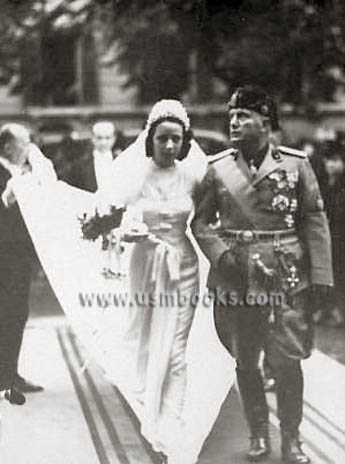
Right, Benito Mussolini walks Gina Ruberti to the altar to become son Bruno's wife on 7 November 1938 in Rome.
Vittorio Mussolini was born on 21 September 1916. He was a pilot and flew for the Italian Air Force during the Second Italo-Ethiopian War, the Spanish Civil War, and World War II. After World War II he became a film critic, editor for the journal Cinema and producer of the early films of Federico Fellini and Michelangelo Antonioni. In 1983 he directed a documentary about his father's life.
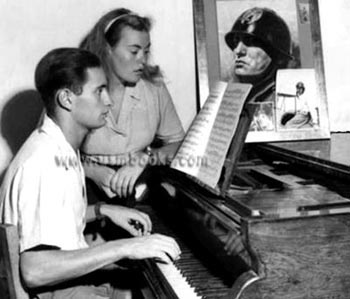
In 1962 he married Anna Maria Scicolone, the younger sister of actress Sophia Loren. They had two daughters, Alessandra and Elisabetta. Today, Alessandra Mussolini who was once a Playboy cover girl, is a mother of three and leads a right-wing political party, Alternativa Sociale, and was a deputy in the European Parliament. With his second wife, actress Carla Puccini, Romano Mussolini had a third daughter, Rachele, named after his mother.
In 2004 he published Il Duce Mio Padre (“My Father the Duce”) which was followed in 2005 by Ultimo Atto (“Last Act”). In both books he recounted his father's last days (even though he was not with his father the last days of his life). He died in Rome on 3 February 2006 and is buried in the Mussolini family crypt in Predappio.
In 2004 he published Il Duce Mio Padre (“My Father the Duce”) which was followed in 2005 by Ultimo Atto (“Last Act”). In both books he recounted his father's last days (even though he was not with his father the last days of his life). He died in Rome on 3 February 2006 and is buried in the Mussolini family crypt in Predappio.
Below, jazz musician Romano Mussolini at the piano with his youngest sister Anna Maria in a post war photo. Notice the picture of their father on top of the piano.
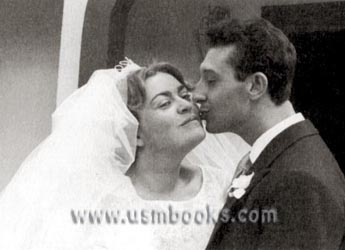
The Mussolini’s youngest daughter Anna Maria was born in 1929. She had polio as a child and limped slightly as a result. The photo on the right shows her in 1960 when she married Giuseppi Negri, an entertainer six years her junior. They had two daughters, Silvia (1961) and Edda (1963), both of them active in Italian politics representing neo-fascist parties.
Anna Maria Mussolini Negri died in 1968 and is buried in the Mussolini family crypt in Predappio. Her older sister Edda is the only child Benito and Rachele Mussolini had that is not buried in the Cripta Mussolini.
Anna Maria Mussolini Negri died in 1968 and is buried in the Mussolini family crypt in Predappio. Her older sister Edda is the only child Benito and Rachele Mussolini had that is not buried in the Cripta Mussolini.
With his first wife Orsola Buvoli he had a son Guido in 1938. Vittorio Mussolini died of kidney failure in Rome on 12 June 1997 at the age of 80 and was survived by his second wife Monica. He is buried in the Mussolini family crypt in Predappio.
After the war, Romano Mussolini (born in 1927), was a musician playing jazz under the assumed name Romano Full and by the mid-1950s he had formed a trio. The Romano Mussolini Trio released a self-titled record through RCA Records in 1956. By the 1960s he had formed the "Romano Mussolini All Stars" which became one of Italy's foremost jazz bands, touring internationally with artists including Dizzy Gillespie, Duke Ellington and Chet Baker. In the 1990s Romano Mussolini recorded two more albums, “Perfect Alibi” and “Soft and Swing”.
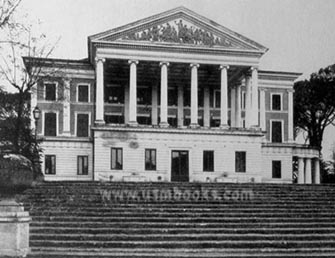
There are persistent rumors that in 1915 Mussolini had a son, Benito Albino, with a woman from Sopramonte (near Trento) called Ida Irene Dalser, who he had allegedly married in 1914. In 1937, at age 57, Ida Dalser died under mysterious circumstances at an asylum on the Venetian island of San Clemente. Benito Albino Mussolini is said to have died in 1942 at an asylum in Milan.
From 1925 until 1943 the Mussolini family lived in Villa Torlonia (shown left) on Via Nomentana in Rome, a princely villa full of frescoes, totally rebuilt during the 19th century by the Torlonia family of bankers. Mussolini paid a symbolic annual rent of one lira to the Torlonia family. On 24 April 1930, the lavish wedding ceremony of Benito Mussolini’s daughter Edda to Count Cianno took place there. During his residence, a bunker was built below the villa to protect Mussolini from gas attacks and air raids. Months before Allied forces arrived, Mussolini abandoned the villa and fled Rome.
In 1944 Villa Torlonia became Allied Military Headquarters as Allied troops fought their way up the Italian peninsula. After the war the house was abandoned and stood unused for about 40 years. The estate now belongs to the city of Rome and is undergoing a six million dollar restoration. Below the public park of Villa Torlonia, extensive catacombs were discovered by accident in 1918. The majority of funerary material found in the catacomb excavations indicated that Jews had used the cemetery between the third and fifth centuries A.D.
This USM Books website is Copyright © 2020 by USM, Inc., and the text and images on it are fully protected by international copyright law. It is therefore, illegal for anyone to take any of the material found here and use it for their own purposes without our written permission, irrespective of any excuse they may feel they have for doing so.


